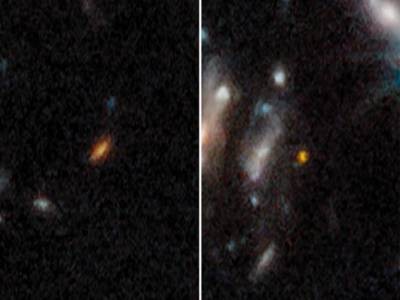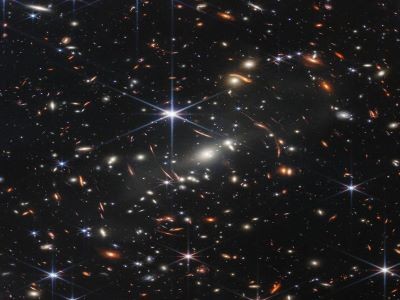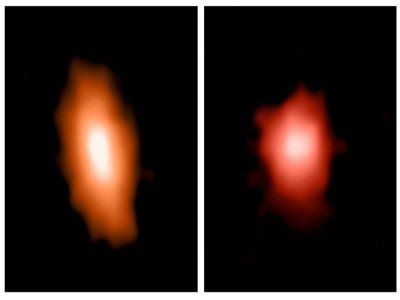These ‘green pea’ galaxies might have helped to end the Universe’s dark age
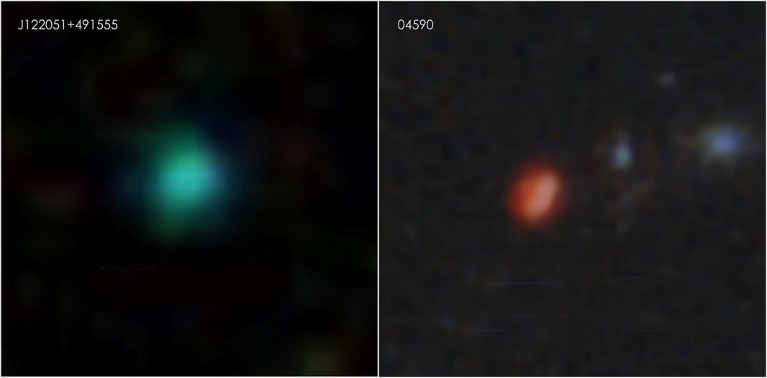
JWST has helped astronomers to discover distant galaxies (right) that are similar to ‘green pea’ galaxies (left, imaged by the Sloan Digital Sky Survey) from the nearby Universe.Credit: SDSS and NASA, ESA, CSA, and STScI
Astronomers using the James Webb Space Telescope (JWST) have found three tiny galaxies that might have helped to trigger one of the greatest remodels in cosmic history.
The findings, presented at a meeting of the American Astronomical Society (AAS) in Seattle, Washington, and published last week1, could explain reionization — the period when harsh radiation tore apart a ‘fog’ of hydrogen atoms hanging over the Universe, rendering stars and galaxies visible for the first time.
A cosmic blackout
In the immediate aftermath of the Big Bang, the Universe was blindingly bright. The residual heat was so great that electrons could not join with protons to form atoms. Instead, the Universe was a seething plasma — a dense glowing gas of electrically charged (or ionized) particles that scattered light, much like a fluorescent light bulb.
JWST spots some of the most distant galaxies ever seen
After about 380,000 years, the expanding Universe had cooled enough for hydrogen atoms to form. Some of those atoms eventually coalesced into the first stars and galaxies. But the surrounding blanket of hydrogen absorbed their light — similar to how a thick fog can block a vehicle’s headlights.
Eventually, this cosmic dark age ended. Energetic radiation broke the intergalactic hydrogen atoms apart — turning them back into lone protons and electrons — in a process called reionization. But ionizing all of the matter between galaxies would take a vast amount of energy, and astronomers have long argued over the exact driver. Perhaps it was starlight from the earliest galaxies. Or maybe the event was caused by supermassive black holes — which tug matter towards them and heat it up.
“One of the big cosmological questions is, what is the cause of reionization?” says Trinh Thuan, an astronomer at the University of Virginia in Charlottesville.
Galactic peas
On 11 July 2022 — about six months after JWST launched — the observatory delivered the deepest and sharpest image of the distant Universe yet seen. The image, which centres on a galaxy cluster called SMACS 0723, contains thousands of galaxies fainter than any seen before. JWST could capture it because it analyses infrared light; as the Universe expands, its most distant galaxies appear to shift out of the visible part of the electromagnetic spectrum and into the infrared. Of the thousands of galaxies in the SMACS 0723 image, researchers decided to make follow-up spectroscopic observations of three that looked as though they might be especially far away.
The emissions spectra of green pea galaxies are similar to those of galaxies from the early Universe, spotted by JWST.Credit: NASA’s Goddard Space Flight Center/Rhoads et al. 2023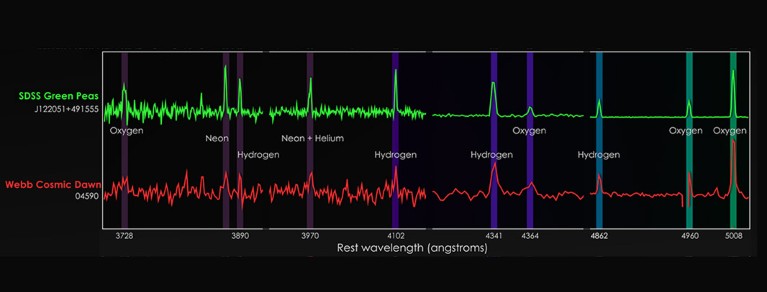
But when James Rhoads, an astronomer at the NASA Goddard Space Flight Center in Greenbelt, Maryland, and his colleagues first saw the trio’s spectra, they realized that the galaxies looked like objects normally found nearby. They had an uncanny resemblance to ‘green pea’ galaxies, oddities first spotted by a citizen-science project called Galaxy Zoo and reported2 in 2009.
Green pea galaxies were named because of their colour and small size. They are just 5% of the size of the Milky Way, and 1% of the mass. But don’t let their small size fool you: they churn out stars at an enormous rate — roughly 100 times as fast as astronomers would expect, given their mass. They also seem to contain relatively few heavy elements. Their greenish hue comes from the glow of ionized oxygen (a relatively light element) heated by newborn stars.
Green peas have fascinated astronomers because, even though they have been observed only in the nearby Universe, their properties resemble those expected for early galaxies. The first galaxies, for example, are thought to contain only light elements because heavy elements need time to form. Sangeeta Malhotra, an astronomer at Goddard Space Flight Center, joked at the AAS meeting on 12 January that they are “Peter Pan galaxies” because they haven’t matured.
Early doppelgängers
This is why Rhoads, Malhotra and their colleagues were excited by the spectra of the trio of galaxies analysed by JWST — the galaxies are from the early cosmos but resemble nearby green peas. “We knew they looked like green-pea spectra the minute we saw them,” Rhoads told Nature.
Landmark Webb telescope releases first science image — astronomers are in awe
Like green peas, the trio are small and have strong emission spectra — meaning they also churn out stars quickly. Similarly, they are low in elements heavier than hydrogen and helium. In fact, the most distant of the three contains roughly 2% as much oxygen as the Milky Way. That’s possibly the lowest amount of oxygen seen in a galaxy yet.
Thuan says he was “amazed” to see the similarity between the spectra that JWST took of these galaxies and those of green peas, which he has long studied.
There is little doubt that they are the same type of object. Before JWST, researchers had measured green peas from ten billion years after the Big Bang, says Daniel Schaerer, an astronomer at the University of Geneva in Switzerland. “And now suddenly we can do the same thing — but just 700 million years after the Big Bang. It’s completely mind-boggling.”
Four revelations from the Webb telescope about distant galaxies
Another reason for excitement dates back to 2016, when astronomers including Thuan reported a green pea sending droves of ionizing photons into the intergalactic medium3. Most galaxies observed in the nearby Universe don’t do this. With so many stars in such a small volume, green peas might be able to punch channels through the interstellar medium, creating an escape route for energetic radiation.
That could mean that objects like the trio from the early Universe produced the energy required to free the cosmos from its dark age. For Thuan, the results are convincing. “Now I really do think that these star-forming dwarf galaxies are the agent of reionization,” he says.
Read More: These ‘green pea’ galaxies might have helped to end the Universe’s dark age


